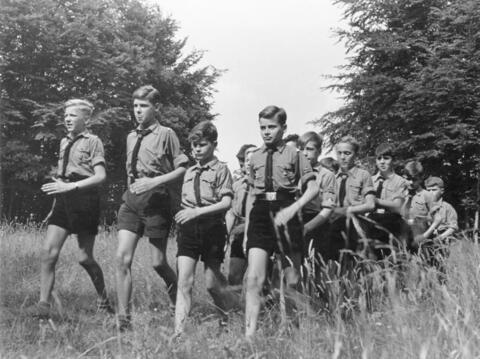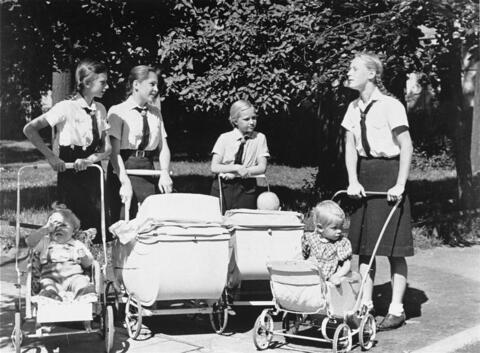Joining the Hitler Youth
At a Glance
Language
English — USSubject
- History
- The Holocaust
In his book Mein Kampf, written in the 1920s, Hitler said, “Whoever has the youth has the future.” Even before they came to power in 1933, Nazi leaders had begun to organize groups that would train young people according to Nazi principles. By 1936, all “Aryan” children in Germany over the age of six were required to join a Nazi youth group. At ten, boys were initiated into the Jungvolk (Young People), and at 14 they were promoted to the Hitler Youth. Their sisters joined the Jungmädel (Young Girls) and were later promoted to the League of German Girls. Hitler hoped that “These young people will learn nothing else but how to think German and act German. . . . And they will never be free again, not in their whole lives.” 1
- 1Max von der Grün, Howl Like the Wolves: Growing Up in Nazi Germany (New York: W. Morrow, 1980), 118–19.
Hitler Youth Hiking

Hitler Youth Hiking
Hitler Youth groups educated young people according to Nazi principles and encouraged comradeship and physical fitness through outdoor activities.
League of German Girls

League of German Girls
The League of German Girls was the girls' wing of the Nazi Party youth movement. A typical activity for members was to go on walks while their mothers were working.
Although membership in the Hitler Youth organizations was compulsory, many young people did not have to be forced to join. In fact, they were eager to do so, drawn by the sense of belonging and importance they felt as members of these groups. In 1938, a boy named Hans Wolf wrote a story about his experiences in the Hitler Youth that was published in a school textbook. The story was called “Comradeship.” It begins:
It was a hot day and we had far to march. The sun was burning down on the heath, which was bereft of trees. The sand was glistening, I was tired. My feet were hurting in those new walking shoes, every step was hurting and all I could think about was rest, water, and shade. I clenched my teeth to keep walking. I was the youngest, and this was my first outing. In front of me strode Rudolf, the leader. He was tall and strong. His backpack was heavy and pressed down on his shoulders. Rudolf carried the bread for us six boys, the cooking pot, and a pile of books, from which he would read us wonderfully thrilling stories, at night in the hostel. My backpack only contained a shirt, a couple of sneakers, washing utensils, and some cooking gear, apart from a tarpaulin for rainy days and straw beds. And yet I thought I could not lug this backpack any longer. My comrades all were somewhat older and had camping experience. They hardly felt the heat and hardship of the march. Every now and then they would sigh and drink lukewarm coffee from their canteens. More and more, I remained behind, even though I tried to make up for my slack by running. Suddenly Rudolf turned around. He stopped and watched me crawling up to him from a distance, while our comrades continued in the direction of a few trees on the horizon. “Tired?” Rudolf asked me, kindly. Ashamed, I had to say yes. Slowly, we walked side by side. I was limping. But I did not want to let on to Rudolf. When we got to a juniper bush, the leader sat down and said: “For a little rest!” Relieved, I threw myself down. I did not want to talk, for I was shy. Rudolf gave me something to drink. I thanked him and leaned back comfortably, glad to be able to stretch my aching feet, and before I knew it I was sleeping. . . . When we resumed our march, my feet hurt much less and my backpack did not press down on me so. I was very glad about that. 1
Like Hans Wolf, Alfons Heck was an enthusiastic participant in the Nazi Youth organizations. In a memoir written many years after World War II, Heck reflected on what made him want to join:
Far from being forced to enter the ranks of the Jungvolk, I could barely contain my impatience and was, in fact, accepted before I was quite 10. It seemed like an exciting life, free from parental supervision, filled with “duties” that seemed sheer pleasure. Precision marching was something one could endure for hiking, camping, war games in the field, and a constant emphasis on sports. . . . To a degree, our pre-war activities resembled those of the Boy Scouts, with much more emphasis on discipline and political indoctrination. There were the paraphernalia and the symbols, the pomp and the mysticism, very close in feeling to religious rituals. One of the first significant demands was the so-called . . . “test of courage,” which was usually administered after a six-month period of probation. The members of my Schar, a platoon-like unit of about 40–50 boys, were required to dive off the three-meter board—about 10 feet high—head first in the town’s swimming pool. There were some stinging belly flops, but the pain was worth it when our Fahnleinführer, the 15-year-old leader of Fahnlein (literally “little flag”), a company-like unit of about 160 boys, handed us the coveted dagger with its inscription Blood and Honor. From that moment on we were fully accepted. 2
Connection Questions
- Why do you think the Nazi leadership wanted all young people to belong to a Nazi youth group? What were the young boys in this reading being prepared for through their participation?
- Why would the authorities want to include Hans Wolf’s story in a school textbook? What values does the story communicate?
- How are the two excerpts (by Hans Wolf and Alfons Heck) different? Looking back, what does Heck see that he might not have been aware of at the time?
- How do the Nazi youth organizations and their symbols connect with the idea of a “national community”? How do they connect with the vision of a nation ready for battle?
- When is it appealing to join a group? Why might some young people have joined even if they didn’t fully agree with Nazi policies?
How to Cite This Reading
Facing History & Ourselves, "Joining the Hitler Youth," last updated August 2, 2016.








